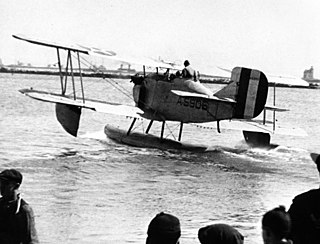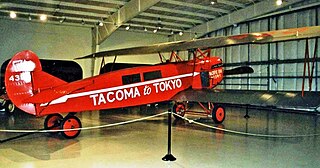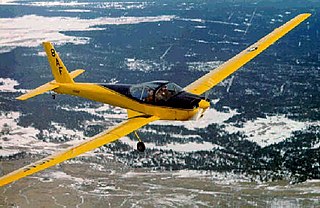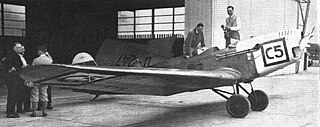
The Aviat Husky is a tandem two-seat, high-wing, utility light aircraft built by Aviat Aircraft of Afton, Wyoming.

The Naval Aircraft Factory TS-1 was an early biplane fighter aircraft of the United States Navy, serving from 1922 to 1929.

The Lockheed Explorer was the least successful wooden airplane design produced by the Lockheed Aircraft Company. The Vega fuselage was combined with a cantilevered low wing. Seating for a single pilot was provided in an open cockpit behind the wings.

The twin-engine F5L was one of the Felixstowe F series of flying boats developed by John Cyril Porte at the Seaplane Experimental Station, Felixstowe, England, during the First World War for production in America.

The Aeromarine 39 was an American two-seat training seaplane ordered by the US Navy in 1917 and built by the Aeromarine Plane and Motor Company of Keyport, New Jersey. Of conventional biplane configuration and construction, the aircraft was designed so that its pontoons could be speedily detached and replaced with wheeled undercarriage for shore operations.

The Douglas T2D was an American twin-engined torpedo bomber contracted by the military, and required to be usable on wheels or floats, and operating from aircraft carriers. It was the first twin-engined aircraft to be operated from an aircraft carrier.

The Elias EM was a 1920s American general-purpose and marine expeditionary biplane built by Elias.

The Curtiss Model R was a utility aircraft produced for the United States Army and Navy during World War I. It was a conventional, two-bay biplane with slightly staggered wings of unequal span. The aircraft was provided with two open cockpits in tandem and fixed tailskid undercarriage, but many were built for the Navy with twin floats replacing the wheels. During the course of the war, Model Rs were used for general liaison and communication duties, as well for observation, training, and as air ambulances. In practice, the Curtiss powerplants supplied with these aircraft proved insufficient and were mostly replaced with Liberty engines. The Navy's Model R-3 floatplane had extended-span, three-bay wings, and was intended for use as a torpedo bomber. Some of these were later fitted with wheeled undercarriage and transferred to the Army as bombers under the designation Model R-9.

The Loening OL, also known as the Loening Amphibian, was an American two-seat amphibious biplane designed by Grover Loening and built by Loening for the United States Army Air Corps and the United States Navy.

The Fokker C.IV was a 1920s Dutch two-seat reconnaissance aircraft designed and built by Fokker.

Klemm L 25, later Klemm Kl 25 was a successful German light leisure, sports and training monoplane aircraft, developed in 1928. More than 600 aircraft were built, and manufacturing licenses were sold to the United Kingdom and the United States.

The Martin T4M was an American torpedo bomber of the 1920s. A development by the Glenn L. Martin Company of their earlier Martin T3M, and, like it a single-engined biplane, the T4M served as the standard torpedo bomber aboard the aircraft carriers of the United States Navy through much of the 1930s.

The Schweizer SGM 2-37 is a two-place, side-by-side, fixed gear, low wing motor glider.

The Short Type 166 was a 1910s British two-seat reconnaissance, bombing and torpedo-carrying folder seaplane, designed by Short Brothers.

The Aeromarine AM-1 was a biplane built to pursue a US Air Mail Service requirement for a nighttime transport.
The Aeromarine BM-1 was a new mail plane design to meet a request for proposal by the US Postal Service.
The Aeromarine EO was a light sport flying boat that was built in the mid-1920s.
The Explorer Ellipse is an American homebuilt aircraft that was designed by Dean Wilson and produced by Explorer Aviation of Grangeville, Idaho. When it was available the aircraft was supplied as a kit for amateur construction.

G Elias & Brother was and American manufacturer of cabinets and aircraft based in Buffalo, New York in the 1920s. A.G. Elias sat on the Manufacturers Aircraft Association's board of directors along with President Frank H. Russell, VP Glenn L. Martin, Charles L. Laurence, Chance M. Vought, S.S. Bradley, George P. Tidmarsh, and Donald Douglas. E.J Elias promoted the construction of a Buffalo municipal airport to aid the local fledgling airplane industry of five aviation companies constructing airplanes and airplane parts. From 1920 to 1925, Elias company's chief engineer, David Earle Dunlap (1896-1957), designed the Elias EM-2 Expeditionary planes. He designed the NBS-3 bomber fuselage and the Elias M-1 Mail plane. Dunlap's Elias TA-1 design was the first United States Army Air Corps Trainer to have a radial engine. After tests a McCook Field, the Army Air Corps selected other manufacturers over the Elias bomber and trainer. The company designed the Elias EM-1 to meet requirements for a multirole amphibian marine expeditionary aircraft. Elias delivered six production Elias EM-2 aircraft with Liberty engines to the United States Navy in 1922.

The Klemm L 26, later Klemm Kl 26, was a low-wing trainer aircraft built by Klemm.
















